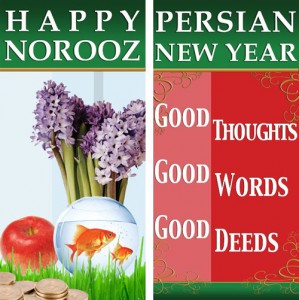Happy Norooz: Persian New Year
Dear Family and Friends –
We wish you a beautiful new day and Happy Norooz!
Persian new year and the moment of spring (time of equinox) is at 10:35 AM (PDT) on Saturday (March 20th). For those who want to know more about Persian New Year, read below.
The Customs and History of New Day Celebrations
Norooz is an ancient holiday that has been embraced by different religions and nationalities. This article will briefly describe its history and tradition. Norooz means new day or daylight. The spellings and pronunciations of Norooz vary, depending on the culture. It symbolizes the first day of spring, at the time of the spring equinox, when sunlight is divided equally between northern and southern hemispheres. This traditional Iranian holiday is not only celebrated within Iran. It is also celebrated in Turkey, Afghanistan, Albania, the countries of Central Asia, Georgia and Azerbaijan, to name a few. It usually is celebrated on the 21st of March of each year, but can be celebrated either a day before or after this date, depending on where it is observed. Besides being a Zoroastrian holiday, Norooz has significance for the Bahai’i religion and Sufism.
Ancient History
In the article “The New Year of Iranian Peoples”, author Dr. Ali Jafari, states that Norooz had its origins some fifteen thousand years ago, during the reign of the mythical Persian King Jamshid. Since life, at that time, revolved around the seasons, spring was seen as a time of new growth, new life and that of abundance. According to Dr. Jafari, it was Jamshid who introduced and started the Norooz celebrations. The prophet Zoroaster, however, later added and put in place the many additional festivals and rituals associated with this celebration. To Zoroastrians, Norooz was a celebration of Ahura Mazda and the Holy Fire.
Persepolis
Twelve centuries later, in 487 BC, the Persian emperor Darius celebrated Norooz festivities at Persepolis. Much of the palace was adorned with statues depicting this celebration. It was here, that Norooz became a very special celebration, and it has been suggested that Persepolis may have been built for the purpose of celebrating Norooz. After Darius, Norooz traditions continued through the Parthian and Sassanid dynasties. It survived the introduction of Islam in 650AD and continued to be celebrated through the subsequent Turkish and Mongol invasions.
Norooz today
Norooz today is commemorated by several events. First, as the spring equinox approaches, all Persian families do a spring cleaning and buy new items, such as clothes. The disposal of the old, with the replacement of the new, symbolizes rebirth during the spring. Also, the night before the last Wednesday of the Persian calendar is the traditional Iranian Festival of Fire. This festival dates back to Zoroastrian times and symbolizes the celebration of the good (light) over the bad (darkness). Small fires are made in the streets and people jump over the fires to symbolically rid themselves of sickness and problems. The fire, in turn, replaces health and good luck to those who jump over it.
At home, a traditional table containing the seven S’s or haft seen is prepared. Seven items, which start with the letter S in Farsi, are placed on this table, each symbolizing different aspects of life. The table is adorned ornately, for it not only has spiritual value to those that make it, but also represents their good taste. On Norooz, family members gather around the haft seen and wait for the exact moment of the spring equinox, at which time gifts are exchanged. The families spend the rest of Norooz visiting close family, relatives and friends, with a number of short visits. Traditionally, the youngest of the family visits the eldest member first. As the day goes on the eldest will reciprocate and repay his respects to the younger family members. Visits are typically short and are highlighted with many varieties of sweets and pastries.
Read more at Suite101: Norooz: Persian New Year: The Customs and History of New Day Celebrations
http://middle-eastern-customs-holidays.suite101.com/article.cfm/norooz#ixzz0ieA13WKJ

